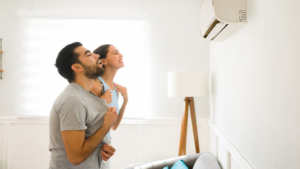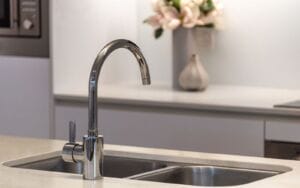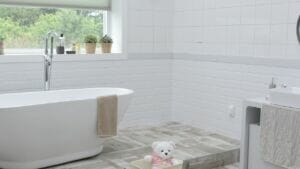Flooring choices can elevate or sabotage your home’s vibe. Hardwood or vinyl? Tile or carpet?
Expert-backed answers await.
We’ve spoken to the pros and curated the top flooring types for homes to suit every nook of your house. From living rooms that dazzle to bedrooms that cocoon, we’ll guide you through the best and let you know what to avoid.
Our Top 3 Picks
- Best For Long-Term Value In Living Spaces: Hardwood Flooring
- Best For High-Traffic Areas: Scratch-Resistant Vinyl Flooring
- Best For Moisture-Prone Areas: Tile Flooring
1. Hardwood Flooring For Living Areas
Best for adding value to your home.
Hardwood adds warmth and elegance to spaces, making it one of the best flooring options for living rooms.
While it’s one of the pricier choices, it’s a durable, timeless investment that you can refinish multiple times. Experts also recommend it to add lasting value to your home.
Features
- Long-lasting for cost-effectiveness.
- Variety of wood species, grains, and stains to suit different tastes.
- Natural aesthetic adds warmth to homes.
Pros
- Timeless appeal.
- Sand and refinish multiple times.
- Increases home value.
Cons
- Sensitive to moisture.
2. Vinyl Flooring For High Traffic Areas
Best For: Busy homes with children and pets.
Expert flooring installers, Go Flooring, rank vinyl as their top choice for homes with pets, thanks to its durability and water resistant nature.
Use it in any high-traffic area, as it handles scratches, spills, and wear, all while being budget-friendly and stylish.
Features
- Water resistant, so won’t absorb spills.
- Wide variety of designs and colors.
- Easy to install, even for DIY beginners.
Pros
- Affordable.
- Easy to clean.
- Durable.
Cons
- Can fade with sun exposure.
- Not as high-end looking as hardwood.
3. Tile Flooring For Bathrooms & Kitchens
Best For: Moisture-prone areas like kitchens and bathrooms.
Tile flooring is unbeatable in high-moisture areas. Both porcelain and ceramic tiles are one of the best flooring choices for bathrooms and kitchens, offering unmatched water resistance and durability.
Features
- Available in many styles, colors, and sizes.
- Stands up to heavy foot traffic.
- Easy to clean and maintain.
Pros
- Ideal for wet areas.
- Durable and long-lasting.
- Customizable design.
Cons
- Cold and hard underfoot.
- Can crack if heavy items are dropped.
4. Carpets For Bedrooms
Best For: A cozy, luxurious feel in bedrooms.
Your bedroom is your sanctuary, so you want it to be soft, warm, and inviting. That’s why the pros agree that carpet is one of the most popular choices for bedroom flooring.
Choose Berber for durability and low maintenance or a plush carpet for a soft underfoot experience.
Features
- Choice of different fibers and colors to match any decor.
- Sound-absorbing to reduce noise, especially in multi-level homes.
- Insulating so helps retain warmth in colder climates.
Pros
- Adds texture and patterns to the room.
- Hides wear and tear well.
- Stain-resistant options.
Cons
- Needs regular maintenance.
- Not as durable in high-traffic areas.
5. Luxury Vinyl Plank For Basements
Best For: Basements prone to moisture and high foot traffic.
Luxury vinyl plank (LVP) has surged in popularity due to its versatility, while its water resistance makes it a great option for basements.
Basements often experience moisture, and LVP withstands humidity while offering a stylish, durable surface. As a plus, it’s easy to install.
Features
- Resists wear and tear, including high foot traffic.
- Available in a wide range of colors and wood-like finishes.
- Easy installation for DIY projects or professional installation.
Pros
- Resistant to moisture and mold.
- Low-maintenance.
- High-end look without the steep price.
Cons
- Not as value-adding as hardwood.
6. Engineered Hardwood For Home Offices
Best For: Stylish and durable home office flooring.
Experts recommend choosing engineered hardwood to give your home office a professional look. It blends the beauty of natural wood with enhanced stability.
A layered construction makes it more resistant to temperature changes and humidity, ensuring long-lasting performance.
Features
- Real wood surface for a premium appearance.
- More stable and resistant to temperature changes than solid hardwood.
- Available in a variety of wood species and finishes.
Pros
- Durable to handle office chairs and foot traffic.
- Easier to install than solid hardwood.
- Affordable.
Cons
- Limited number of refinishes.
- Needs protection from heavy furniture.
How To Choose The Best Flooring Type For Your Home
When deciding on the right flooring for your home, consider these factors:
Traffic Level
High-traffic areas like living rooms and hallways require durable flooring like hardwood or tile.
Moisture-Resistance
For kitchens, bathrooms, and basements, choose water-resistant options like vinyl or tile or LVP.
Pet-Friendly
Vinyl is one of the best flooring options for homes with pets due to its scratch resistance and durability.
What To Avoid
Before you make your final decisions, here are a few flooring options you’ll want to steer clear of in certain rooms.
- Hardwood In Wet Areas
Avoid hardwood in bathrooms or kitchens as water and moisture cause warping and buckling.
- Carpet In High-Traffic Or Wet Areas
In moisture-prone rooms or busy spaces, carpet will wear down fast and might start to mold.
- Laminate In Wet Spaces
Laminate looks great but doesn’t stand up to water damage, so it’s not a good choice for bathrooms or basements.
Best Flooring Types: Frequently Asked Questions
What’s the best flooring for a kids’ room?
Carpet is the best flooring for a kids’ room because it’s soft and safe, providing a comfortable surface for play.
What is the best flooring to use throughout the house?
Hardwood is one of the best flooring options for most rooms, but you’ll want to switch to tile or vinyl in areas with high moisture.
Conclusion
Choosing the right flooring can make or break your home’s feel and function.
Remember: hardwood shines in living areas, vinyl tackles high-traffic zones, and tile conquers moisture-prone spaces. Match your flooring to each room’s unique demands – from cozy carpets in bedrooms to durable options in busy areas.
By selecting wisely, you’ll create a foundation that enhances your home’s comfort, style, and value for years to come.



